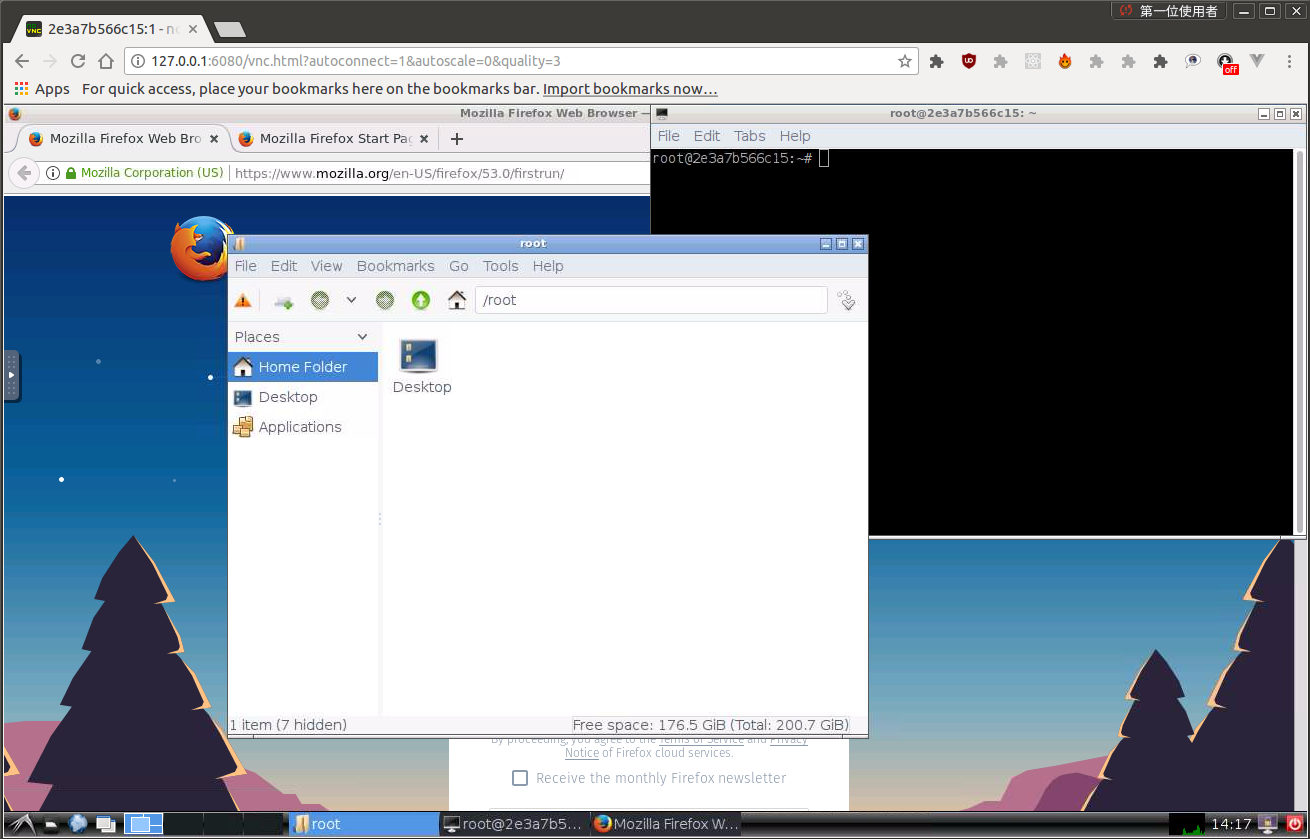https://github.com/tacc/docker-ubuntu-vnc-desktop-application-base
https://github.com/tacc/docker-ubuntu-vnc-desktop-application-base
Last synced: 9 months ago
JSON representation
- Host: GitHub
- URL: https://github.com/tacc/docker-ubuntu-vnc-desktop-application-base
- Owner: TACC
- License: apache-2.0
- Created: 2019-10-07T22:11:38.000Z (about 6 years ago)
- Default Branch: generic-portal-vnc
- Last Pushed: 2022-12-10T06:36:07.000Z (about 3 years ago)
- Last Synced: 2024-04-16T02:11:41.283Z (over 1 year ago)
- Language: JavaScript
- Size: 12.6 MB
- Stars: 1
- Watchers: 7
- Forks: 2
- Open Issues: 25
-
Metadata Files:
- Readme: README.md
- License: LICENSE
Awesome Lists containing this project
README
docker-ubuntu-vnc-desktop
=========================
[](https://hub.docker.com/r/dorowu/ubuntu-desktop-lxde-vnc/)
[](https://hub.docker.com/r/dorowu/ubuntu-desktop-lxde-vnc/)
Docker image to provide HTML5 VNC interface to access Ubuntu 16.04 LXDE desktop environment.
Quick Start
-------------------------
Run the docker container and access with port `6080`
```
docker run -p 6080:80 -v /dev/shm:/dev/shm dorowu/ubuntu-desktop-lxde-vnc
```
Browse http://127.0.0.1:6080/

**Ubuntu Version**
Choose your favorite Ubuntu version with [tags](https://hub.docker.com/r/dorowu/ubuntu-desktop-lxde-vnc/tags/)
- bionic: Ubuntu 18.04 (latest)
- bionic-lxqt: Ubuntu 18.04 LXQt
- xenial: Ubuntu 16.04
- trusty: Ubuntu 14.04
VNC Viewer
------------------
Forward VNC service port 5900 to host by
```
docker run -p 6080:80 -p 5900:5900 -v /dev/shm:/dev/shm dorowu/ubuntu-desktop-lxde-vnc
```
Now, open the vnc viewer and connect to port 5900. If you would like to protect vnc service by password, set environment variable `VNC_PASSWORD`, for example
```
docker run -p 6080:80 -p 5900:5900 -e VNC_PASSWORD=mypassword -v /dev/shm:/dev/shm dorowu/ubuntu-desktop-lxde-vnc
```
A prompt will ask password either in the browser or vnc viewer.
HTTP Base Authentication
---------------------------
This image provides base access authentication of HTTP via `HTTP_PASSWORD`
```
docker run -p 6080:80 -e HTTP_PASSWORD=mypassword -v /dev/shm:/dev/shm dorowu/ubuntu-desktop-lxde-vnc
```
SSL
--------------------
To connect with SSL, generate self signed SSL certificate first if you don't have it
```
mkdir -p ssl
openssl req -x509 -nodes -days 365 -newkey rsa:2048 -keyout ssl/nginx.key -out ssl/nginx.crt
```
Specify SSL port by `SSL_PORT`, certificate path to `/etc/nginx/ssl`, and forward it to 6081
```
docker run -p 6081:443 -e SSL_PORT=443 -v ${PWD}/ssl:/etc/nginx/ssl -v /dev/shm:/dev/shm dorowu/ubuntu-desktop-lxde-vnc
```
Screen Resolution
------------------
The Resolution of virtual desktop adapts browser window size when first connecting the server. You may choose a fixed resolution by passing `RESOLUTION` environment variable, for example
```
docker run -p 6080:80 -e RESOLUTION=1920x1080 -v /dev/shm:/dev/shm dorowu/ubuntu-desktop-lxde-vnc
```
Default Desktop User
--------------------
The default user is `root`. You may change the user and password respectively by `USER` and `PASSWORD` environment variable, for example,
```
docker run -p 6080:80 -e USER=doro -e PASSWORD=password -v /dev/shm:/dev/shm dorowu/ubuntu-desktop-lxde-vnc
```
Deploy to a subdirectory (relative url root)
--------------------------------------------
You may deploy this application to a subdirectory, for example `/some-prefix/`. You then can access application by `http://127.0.0.1:6080/some-prefix/`. This can be specified using the `RELATIVE_URL_ROOT` configuration option like this
```
docker run -p 6080:80 -e RELATIVE_URL_ROOT=some-prefix dorowu/ubuntu-desktop-lxde-vnc
```
NOTE: this variable should not have any leading and trailing splash (/)
Sound (Preview version and Linux only)
--------------------------------------
It only works in Linux.
First of all, insert kernel module `snd-aloop` and specify `2` as the index of sound loop device
```
sudo modprobe snd-aloop index=2
```
Start the container
```
docker run -it --rm -p 6080:80 --device /dev/snd -e ALSADEV=hw:2,0 dorowu/ubuntu-desktop-lxde-vnc
```
where `--device /dev/snd -e ALSADEV=hw:2,0` means to grant sound device to container and set basic ASLA config to use card 2.
Launch a browser with URL http://127.0.0.1:6080/#/?video, where `video` means to start with video mode. Now you can start Chromium in start menu (Internet -> Chromium Web Browser Sound) and try to play some video.
Following is the screen capture of these operations. Turn on your sound at the end of video!
[](http://www.youtube.com/watch?v=Kv9FGClP1-k)
Generate Dockerfile from jinja template
-------------------
Dockerfile and configuration can be generated by template.
- arch: one of `amd64` or `armhf`
- flavor: refer to file in flavor/`flavor`.yml
- image: base image
- desktop: desktop environment which is set in flavor
- addon_package: Debian package to be installed which is set in flavor
Dockerfile and configuration are re-generate if they do not exist. Or you may force to re-generate by removing them with the command `make clean`.
Troubleshooting and FAQ
==================
1. boot2docker connection issue, https://github.com/fcwu/docker-ubuntu-vnc-desktop/issues/2
2. Multi-language supports, https://github.com/fcwu/docker-ubuntu-vnc-desktop/issues/80
3. Autostart, https://github.com/fcwu/docker-ubuntu-vnc-desktop/issues/85
4. x11vnc arguments(multiptr), https://github.com/fcwu/docker-ubuntu-vnc-desktop/issues/101
5. firefox/chrome crash (/dev/shm), https://github.com/fcwu/docker-ubuntu-vnc-desktop/issues/112
6. resize display size without destroying container, https://github.com/fcwu/docker-ubuntu-vnc-desktop/issues/115#issuecomment-522426037
License
==================
See the LICENSE file for details.